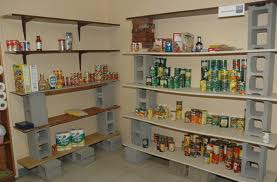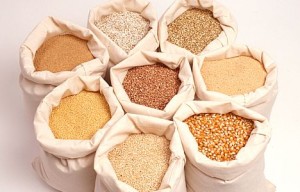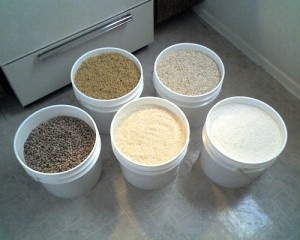Well it's on to a new adventure, calling and responsibility.
This will be my last post for this ward blog. From here on out I will use it as a reference on how, where and when. Hope you do too.
Enjoy this well put together article on Food Storage, then give it some thought and plan accordingly...PLEASE
Do You Have Enough Food Storage?
By Kellene Bishop
Now, have said that, the question posed above is a common question in my line of work because others don't necessarily share my point of view. That's okey dokey. Regarding having "enough" there are certainly plenty of numbers thrown out there. I do have an opinion to add to that list of suggested amounts, of course, though I confess that my answers aren’t always well received—I have this nasty habit of sharing facts that may contradict what a person has relied upon for a long time. *wink* So, how much food do you really need in order to have a year’s supply for your family at any given time?
thrown out there. I do have an opinion to add to that list of suggested amounts, of course, though I confess that my answers aren’t always well received—I have this nasty habit of sharing facts that may contradict what a person has relied upon for a long time. *wink* So, how much food do you really need in order to have a year’s supply for your family at any given time?
security . I will never forget the time that my husband was invited to “take a peek” at the newly acquired “food storage” that a friend of ours had purchased. This friend was just so tickled and so proud of himself for finally getting out there and doing something about providing better for his family in the future. Frankly, I always join in someone’s peace of mind when they are moving towards a more self-sufficient life. But on this occasion, my joy for this friend was short-lived. This friend has a wife and 5 children, so imagine my husband’s surprise when our friend showed him 365 regular sized soup cans of a hearty stew. Yes, you read that right, folks. In this man’s mind, 365 cans of soup for a family of 7 is enough food for a year. Ooops! Now mind you, I’m a believer in miracles yesterday and today, but as I understand things, I don’t think that we’re supposed to put ourselves in a position in which we require a miracle to survive, as long as we can help it. There are SO many things wrong with this scenario I’ve just shared with you, but let’s just focus on the obvious here—he doesn’t have anywhere NEAR enough food for his family to last him a year.
 In the world of “emergency preparedness” there are many resources which will help you calculate exactly how much food
In the world of “emergency preparedness” there are many resources which will help you calculate exactly how much food storage should you stock up on for your targeted time frame. An internet search for a “food storage calculator” will bring up lots of nifty little sources. Since the Church of Jesus Christ of Latter-Day Saints (commonly referred to as “Mormons”) has been urging it’s members consistently since the 1800’s to have “food storage” I’m comfortable sharing with you there suggested guidelines to help you get an idea of “how much food storage do I need.” See the calculator here:
The first thing you will see on the usualfood storage lists that are out there is the category of “grains”. The standard rule of thumb you’ll hear most often is 300 pounds of grains per person, regardless of what their age is, for a year. I always plead that people NOT quibble about the ages of the persons in their family because it's obviously likely to change… after all, kids get bigger with time, not smaller. So since one doesn’t know when they will have to rely strictly on their year’s supply, it’s a good idea to prepare with the “worst case scenario” of needs of older kids in mind.
 Now grains constitutes all kinds of grains items such as flour, pasta, rice, muffin mixes, popcorn, spelt, quinoa, wheat, cereals, etc. (Notice we’re talking about WEIGHT here, so keep that in mind when you’re looking at that very big, but oh, so light box of Cheerios.) Again, the most common rule of thumb amount for grains is 300 pounds. I've actually never said anything less than 350 pounds, but regardless, nearly all of you who are reading this will have that momentary shock to the system as you contemplate just how much grain that would mean for a family of 4, let alone 7. Imagine how much that family on cable TV with 19 kids would need! Whooee!
Now grains constitutes all kinds of grains items such as flour, pasta, rice, muffin mixes, popcorn, spelt, quinoa, wheat, cereals, etc. (Notice we’re talking about WEIGHT here, so keep that in mind when you’re looking at that very big, but oh, so light box of Cheerios.) Again, the most common rule of thumb amount for grains is 300 pounds. I've actually never said anything less than 350 pounds, but regardless, nearly all of you who are reading this will have that momentary shock to the system as you contemplate just how much grain that would mean for a family of 4, let alone 7. Imagine how much that family on cable TV with 19 kids would need! Whooee!
Inevitably when I share the magic number of 350 pounds I will always hear someone declare “Oh, there’s no way that I consume that much grain in a year.” Well, either you live off of Hershey’s candy bars and plan on just leaving this life in a chocolate coma--perhaps not the worst that could happen *grin*—or you really don’t have a grasp on just how much a person actually consumes in a year. So think about this for a moment. Does your money ever last as long as you think it will? Surely you’ve experienced that “holy cow” moment in your life when you realized how fast that “extra $100” in your wallet disappeared. And surely you’ve at least seen plenty of folks who thought they had enough gas in their car to get them to their destination even though the needle was sitting on “empty.” And of course you’ve all experienced one of those days where you have no idea where all the time went, right? Well then, isn’t it fair to say that when it comes to the topic of long-term food consumption there just might be a bit of perception error? And I’m about to show you just how far off that perception is in most homes--and I"m talking about homes in which people actually consider themselves to be mindful of these kinds of things. Wait until I show you just how LITTLE that 300-350 pounds of grain in your food storage will provide you in the form of daily meals. (corrected)
The absolute minimum amounts of recommend food supplies for a year which provides you with "about a half of a small loaf of bread daily along with 3 small servings of beans" (corrected)are as follows:
 300 pounds of grains per person (FYI, a pound of grain--depending on type--is between 2 1/4 - 2 1/2 cups)
300 pounds of grains per person (FYI, a pound of grain--depending on type--is between 2 1/4 - 2 1/2 cups)
75 pounds of legumes (pinto, black, red, lima, kidney, turtle, garbanzo, etc.)
75 pounds of milk (powdered, evaporated, etc.)
65 pounds of sweeteners (sugar, molasses, honey, etc.)
4 pounds of shortening*
2 gallons of oil *
2.5 pounds of leaving agents (yeast, baking soda, baking powder, etc.)
5 pounds of salt
45 gallons of water **
*This does NOT include other fats which are absolutely necessary for proper organ function such as butter, coconut oil, peanut butter, nuts, etc.
 **this is ONLY enough for an average of 3 daily consumable ration examples (corrected) as noted below and does NOT include the minimum of 2 quarts of water each person should drink daily—minimum for proper body function, nor does it take into account any additional water needs such as laundry, bathing, sanitation, or any additional cooking.
**this is ONLY enough for an average of 3 daily consumable ration examples (corrected) as noted below and does NOT include the minimum of 2 quarts of water each person should drink daily—minimum for proper body function, nor does it take into account any additional water needs such as laundry, bathing, sanitation, or any additional cooking.
You see this pittance of an amount of beans and this tiny, UNdelectable 4 inch“loaf” of bread? That’s what this “massive” amount of food translates into what you get to look forward to three times a day for one person. Mmmmm…you’re just salivating like crazy right now aren’t you? Wow! That’s quite the feast there… Bet you can’t wait to dig into that, eh?
Here’s what was used to make this bountiful feast you see in the picture:
¾ cup of grain (equals about 1 to 1 ¼ cup of flour IF and only IF you’re able to mill grind it)
1/3 cup of beans
2 Tablespoons of powdered milk
2 Tablespoons of oil (fat, lard, butter, etc.)
1 Tablespoon of sugar (in order to best activate the yeast)
2 ½ teaspoons of yeast
2 ½ teaspoons of salt
And approximately 24 ounces of water to cook the beans, make the bread, and for drinking water in order to ward off digestive ailments.
Now, is there anything else missing…you know like fruits, vegetables, flavorings and spice, comfort foods, etc? How about some MEAT like chicken, ham, or beef? And where in the heck is the chocolate—medication of the sane?! And this isn’t exactly going to make my Blue Ribbon 100% Whole Wheat Bread either. Even if it did, I can tell you that my husband can happily polish off a whole loaf of a REAL sized loaf of bread in the first 24 hours after I’ve baked it, and I assure you, that’s not all he eats when I make bread…the irresistible, moist, light bread is consumed in addition to his regular meals. Seriously, can you even fathom serving your children or your elderly parents and grandparents nothing but this speck of food every day? This puts things in a little different perspective, I hope.
Perhaps now you understand why I cringe when people focus so much on traditional “food storage”? It’s simply NOT as abundant as people think it is, nor does it provide anywhere near enough calories to THRIVE. This kind of a minimalistic “preparedness” will not serve much more than to buy you a little bit more time before your most certain death—especially if you haven’t taken thought for the tools and skills needed to GROW and produce additional foods so that you’re not doomed for death by starvation on Day #375.
Consider this also…what about your INCREASED physical demands for nutrients because you’re having to do more physical labor that a true crisis scenario would demand? How about just lugging your bug-out bag for 5 miles every day? You think that this paltry amount of food will be enough to fuel your body and your spirit so that you can do that? How about the energy you’ll need to shovel a latrine, be alert and on guard, or washing laundry by hand? Can you also imagine just how grumpy people would be in an already stressful situation because this is all they have to eat?
physical labor that a true crisis scenario would demand? How about just lugging your bug-out bag for 5 miles every day? You think that this paltry amount of food will be enough to fuel your body and your spirit so that you can do that? How about the energy you’ll need to shovel a latrine, be alert and on guard, or washing laundry by hand? Can you also imagine just how grumpy people would be in an already stressful situation because this is all they have to eat?
So, do you have enough food storage? Um…I’m thinking that at least double these minimal amounts of food is much more in line with the reality you’ll want to deal with in the event that life drastically changes for us.
“How much food storage do I need?”
For the record, I absolutely loathe the term "food storage." It's no longer used in our household because I'm not a squirrel. As such I don't purchase items which serve no other purpose than to be stuffed away into a corner, only to promise unpleasant eating later. If I don't eat it or know how to use it, it doesn't come into our home. And if it comes into our home, we use it and are very familiar with it.Now, have said that, the question posed above is a common question in my line of work because others don't necessarily share my point of view. That's okey dokey. Regarding having "enough" there are certainly plenty of numbers
 thrown out there. I do have an opinion to add to that list of suggested amounts, of course, though I confess that my answers aren’t always well received—I have this nasty habit of sharing facts that may contradict what a person has relied upon for a long time. *wink* So, how much food do you really need in order to have a year’s supply for your family at any given time?
thrown out there. I do have an opinion to add to that list of suggested amounts, of course, though I confess that my answers aren’t always well received—I have this nasty habit of sharing facts that may contradict what a person has relied upon for a long time. *wink* So, how much food do you really need in order to have a year’s supply for your family at any given time?Do you have the right kind of food storage?
In my book, there’s nothing worse in my book than having a false sense of In the world of “emergency preparedness” there are many resources which will help you calculate exactly how much food
In the world of “emergency preparedness” there are many resources which will help you calculate exactly how much food The first thing you will see on the usual
 Now grains constitutes all kinds of grains items such as flour, pasta, rice, muffin mixes, popcorn, spelt, quinoa, wheat, cereals, etc. (Notice we’re talking about WEIGHT here, so keep that in mind when you’re looking at that very big, but oh, so light box of Cheerios.) Again, the most common rule of thumb amount for grains is 300 pounds. I've actually never said anything less than 350 pounds, but regardless, nearly all of you who are reading this will have that momentary shock to the system as you contemplate just how much grain that would mean for a family of 4, let alone 7. Imagine how much that family on cable TV with 19 kids would need! Whooee!
Now grains constitutes all kinds of grains items such as flour, pasta, rice, muffin mixes, popcorn, spelt, quinoa, wheat, cereals, etc. (Notice we’re talking about WEIGHT here, so keep that in mind when you’re looking at that very big, but oh, so light box of Cheerios.) Again, the most common rule of thumb amount for grains is 300 pounds. I've actually never said anything less than 350 pounds, but regardless, nearly all of you who are reading this will have that momentary shock to the system as you contemplate just how much grain that would mean for a family of 4, let alone 7. Imagine how much that family on cable TV with 19 kids would need! Whooee!Inevitably when I share the magic number of 350 pounds I will always hear someone declare “Oh, there’s no way that I consume that much grain in a year.” Well, either you live off of Hershey’s candy bars and plan on just leaving this life in a chocolate coma--perhaps not the worst that could happen *grin*—or you really don’t have a grasp on just how much a person actually consumes in a year. So think about this for a moment. Does your money ever last as long as you think it will? Surely you’ve experienced that “holy cow” moment in your life when you realized how fast that “extra $100” in your wallet disappeared. And surely you’ve at least seen plenty of folks who thought they had enough gas in their car to get them to their destination even though the needle was sitting on “empty.” And of course you’ve all experienced one of those days where you have no idea where all the time went, right? Well then, isn’t it fair to say that when it comes to the topic of long-term food consumption there just might be a bit of perception error? And I’m about to show you just how far off that perception is in most homes--and I"m talking about homes in which people actually consider themselves to be mindful of these kinds of things. Wait until I show you just how LITTLE that 300-350 pounds of grain in your food storage will provide you in the form of daily meals. (corrected)
The absolute minimum amounts of recommend food supplies for a year which provides you with "about a half of a small loaf of bread daily along with 3 small servings of beans" (corrected)are as follows:
 300 pounds of grains per person (FYI, a pound of grain--depending on type--is between 2 1/4 - 2 1/2 cups)
300 pounds of grains per person (FYI, a pound of grain--depending on type--is between 2 1/4 - 2 1/2 cups)75 pounds of legumes (pinto, black, red, lima, kidney, turtle, garbanzo, etc.)
75 pounds of milk (powdered, evaporated, etc.)
65 pounds of sweeteners (sugar, molasses, honey, etc.)
4 pounds of shortening*
2 gallons of oil *
2.5 pounds of leaving agents (yeast, baking soda, baking powder, etc.)
5 pounds of salt
45 gallons of water **
*This does NOT include other fats which are absolutely necessary for proper organ function such as butter, coconut oil, peanut butter, nuts, etc.
 **this is ONLY enough for an average of 3 daily consumable ration examples (corrected) as noted below and does NOT include the minimum of 2 quarts of water each person should drink daily—minimum for proper body function, nor does it take into account any additional water needs such as laundry, bathing, sanitation, or any additional cooking.
**this is ONLY enough for an average of 3 daily consumable ration examples (corrected) as noted below and does NOT include the minimum of 2 quarts of water each person should drink daily—minimum for proper body function, nor does it take into account any additional water needs such as laundry, bathing, sanitation, or any additional cooking.That's a LOT of Food Storage!!!
So, you see these massive amounts of food storage and think “Holy cow, that’s a LOT!” but I’m going to show you what JUST THESE items translate into a 3 times (corrected)DAILY RATION basis. Ready? Brace yourself…You see this pittance of an amount of beans and this tiny, UNdelectable 4 inch“loaf” of bread? That’s what this “massive” amount of food translates into what you get to look forward to three times a day for one person. Mmmmm…you’re just salivating like crazy right now aren’t you? Wow! That’s quite the feast there… Bet you can’t wait to dig into that, eh?
Here’s what was used to make this bountiful feast you see in the picture:
¾ cup of grain (equals about 1 to 1 ¼ cup of flour IF and only IF you’re able to mill grind it)
1/3 cup of beans
2 Tablespoons of powdered milk
2 Tablespoons of oil (fat, lard, butter, etc.)
1 Tablespoon of sugar (in order to best activate the yeast)
2 ½ teaspoons of yeast
2 ½ teaspoons of salt
And approximately 24 ounces of water to cook the beans, make the bread, and for drinking water in order to ward off digestive ailments.
What do YOU want your food storage to look like?
Now, is there anything else missing…you know like fruits, vegetables, flavorings and spice, comfort foods, etc? How about some MEAT like chicken, ham, or beef? And where in the heck is the chocolate—medication of the sane?! And this isn’t exactly going to make my Blue Ribbon 100% Whole Wheat Bread either. Even if it did, I can tell you that my husband can happily polish off a whole loaf of a REAL sized loaf of bread in the first 24 hours after I’ve baked it, and I assure you, that’s not all he eats when I make bread…the irresistible, moist, light bread is consumed in addition to his regular meals. Seriously, can you even fathom serving your children or your elderly parents and grandparents nothing but this speck of food every day? This puts things in a little different perspective, I hope.
Perhaps now you understand why I cringe when people focus so much on traditional “food storage”? It’s simply NOT as abundant as people think it is, nor does it provide anywhere near enough calories to THRIVE. This kind of a minimalistic “preparedness” will not serve much more than to buy you a little bit more time before your most certain death—especially if you haven’t taken thought for the tools and skills needed to GROW and produce additional foods so that you’re not doomed for death by starvation on Day #375.
Consider this also…what about your INCREASED physical demands for nutrients because you’re having to do more
 physical labor that a true crisis scenario would demand? How about just lugging your bug-out bag for 5 miles every day? You think that this paltry amount of food will be enough to fuel your body and your spirit so that you can do that? How about the energy you’ll need to shovel a latrine, be alert and on guard, or washing laundry by hand? Can you also imagine just how grumpy people would be in an already stressful situation because this is all they have to eat?
physical labor that a true crisis scenario would demand? How about just lugging your bug-out bag for 5 miles every day? You think that this paltry amount of food will be enough to fuel your body and your spirit so that you can do that? How about the energy you’ll need to shovel a latrine, be alert and on guard, or washing laundry by hand? Can you also imagine just how grumpy people would be in an already stressful situation because this is all they have to eat?So, do you have enough food storage? Um…I’m thinking that at least double these minimal amounts of food is much more in line with the reality you’ll want to deal with in the event that life drastically changes for us.
Read more at http://www.preparednesspro.com/do-you-have-enough#AhJcAiZmvXeWKSAi.99



No comments:
Post a Comment